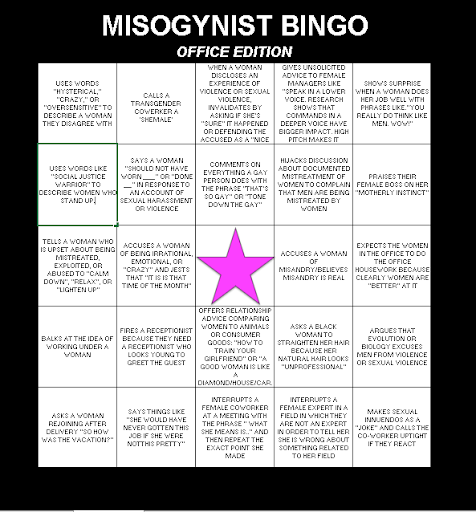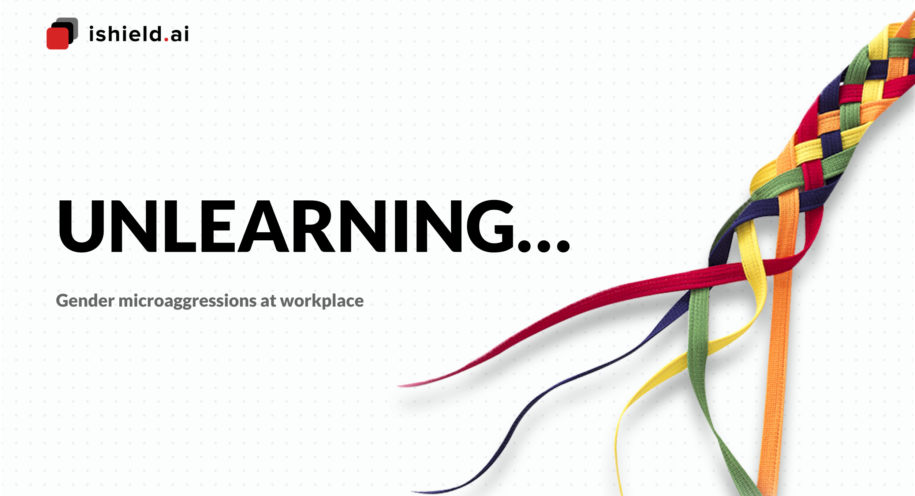Gender microaggressions at workplace
That the corporate world is a white cisgender man’s space is a truism by now. This is why we have best selling “classics” like Nice Girls Don’t Get the Corner Office coaching wide-eyed young professionals on how to smile less and be more like ‘men’ if they want professional success. Such advice only seems logical when one is confronted with the following statistics.
As of 2021, only 41 of the Fortune 500 companies have a woman CEO and only two of them are Black.
Women earned 82.3% of what men earned in 2019 for the same jobs.
Between 2015 and 2020, Women held just 38 percent of managerial positions.
Only about 1 in 5 C-suite executives is a woman, and only 1 in 25 is a woman of color.
55% of women in senior leadership, 48% of lesbian women, and 45% of women in technical fields report they’ve been sexually harassed
These inequalities and disparities we see at the macro level, i.e at an organizational or an industry level, are easier to detect, measure and capture in scorecards and bar-graphs. However, these are only outward symptoms of a deep rooted systemic discrimination that is rampant at a micro-level, i.e. at an interpersonal level within an organization. Over the past decade, what has become unequivocally clear is that it is these micro level discriminations or microaggressions that need our desperate attention.
What are microaggressions?
There is a myth that the tribals of Solomon Islands don’t cut down trees. When they want to fell a tree, they surround it and curse it for hours each day. Within a few weeks, apparently the tree dries up and dies. I don’t know if this would work on trees, but it can definitely work on human beings. The words we use, the messages we pass, the content we consume indeed have the power to make or break. People constantly, subliminally internalize the messages they repeatedly encounter about themselves and other people. These ideas are what turn into lasting world views, belief systems, bias and stereotypes.
Starting from a very young age, we start forming sex-based gender stereotypes and accept our gender roles as a given. We get socially rewarded for behaviours conforming to our gender roles and get punished if we flout them. By the time we reach adulthood, most of us have very strongly internalized our binary gender identity and the associated stereotypes. They become such an indelible part of our cultural psyche and personal identity that questioning them, let alone disrupting them, can cause existential crises for many, even if it does not correspond to one’s lived reality. Every contrary information to our inherent bias is either denied, rationalized or vehemently resisted by us and microaggressions are the psychological tool we use for this.
As adults, we carry many of these inherited stereotypes to the workplace and play our part in propagating it further. Take a look at this misogynist Bingo and cross off every such statement/situation you have encountered at the workplace.

Every single microaggression listed in the chart is based on gender stereotype classified across two categories — communal and agentic. Women are usually described and circularly expected to be communal – i.e. warm, nurturing, kind, submissive, homebodies whereas men are described and are in turn expected to be agentic – which refers to behaviors such as being assertive, dominant and controlling.
More than men, these stereotypes or microaggressions affect women and gender diverse people the most. In the form of friendly advice, observation, jokes, praise or harassment, the writing on the wall “You don’t belong here” is very clear. Women of color, people from LGBT community face much harsher penalties and stigma in lieu of their race and sexual identity. This is the reason why approximately three-quarters of all lesbian, gay, bisexual, and transgender (LGBT) workers choose to hide who they are in the workplace and pretend to conform to heteronormative standards.
This is not to say that men do not face any gender-based biases. A new study from Catalyst reveals that 22% of men surveyed also experience high levels of masculine anxiety at work.
Why microaggressions are so dangerous?
The subtlety
What makes microaggressions so dangerous is that they are hard to detect. People who are involved do not recognise it for its aggressive nature as the comments and actions look seemingly benign and well intentioned.
Lack of intention and perceived minimal harm
Most of the time, there is no obvious intent to hurt. The remark could very well be an honest mistake, lack of awareness, or an ill-advised attempt at humour. Benevolent sexism, for example, hides the stereotype in an outward praise. A comment such as “Mariam is a super mom. She cooks food for her entire family before leaving for work”, is a praise for conforming to a gender stereotype of women as homemakers. Similarly, a statement such as “It is rare to find women who can code so well. This is great stuff”, harbours the negative stereotype “Women can’t code” but is intended as a praise.
However, it is not the intent but the impact such haphazard comments create that needs focus. Research shows that even benevolently sexist feedback can undermine a woman’s evaluation of her personal skills, and can cause cardiovascular reactivity in them similar to a threat state.
The cumulative nature
A single instance of microaggression may not seem so bad, but compounded over time, they can have a serious impact on an employee’s physical health, and psychological well-being. The “Emotional Tax” of being constantly on guard to protect themselves from microaggressions can have severe mental repercussions. However, the worst impact microaggressions can have is that the affected people start accepting these judgements as facts, not very different from the mythical trees on Soloman island.
Responding to microaggressions is a Catch-22 situation for women
Because of their subtle and ‘open-to-interpretation’ nature, microaggressions can be emotionally draining to confront. Further, women face what is termed as the ‘Likeability penalty’. If a woman is assertive and calls out sexism she is deemed unlikeable, but if she stays silent, she feels guilty and often has to cope with it by rationalizing the perpetrator’s action, or by blaming herself. Another reason people avoid calling out misogyny is that they make people defensive and can further escalate the cycle of aggression.
Lack of institutional support
People are hesitant to call out microaggressions in organizational climates that were perceived to be more silencing, combative and futile.
Impact on organizations and on employees
Microaggressions can adversely impact organizational health by creating a toxic work culture where employees do not feel free to be themselves. Microaggressions can undermine group identities, lower work productivity and stagnate the innovation afforded by diverse perspectives.
Forbes reports a recent study from the Center for Talent Innovation finds that perceived bias in the workplace dramatically correlates with behaviors such as employee flight risk and brand sabotage. People who perceive bias are:
More than 3 times as likely to leave their employers within a year.
2.6 times as likely to have withheld ideas or solutions and be generally disengaged.
5 times as likely to speak about their company in a negative manner on social media.
How can gender microaggressions be tackled?
Increase representation of women and trans-people in your workplace
Research shows that company profits and employee satisfaction can be close to 50% higher if women are well represented at the top. Employees generally want to work in organizations where people, like them, are present at the executive ranks. To ensure representation and to curb bias, companies can standardize their hiring practices, resume screenings, interviews, performance evaluations and promotion policies. Allyship and mentorship programs for women and people from other marginalised groups can greatly help their cause. Doing away with pay secrecy policies for social accountability and facilitating working mothers with child and elder care responsibilities, further helps women gain trust in the organization. Similarly adopting Basic Trans-Inclusive Policies such as bathroom access and pronouns, name usage policies, gender-transitioning support etc can be a huge relief to the trans-workforce.
Invest in long-term diversity and inclusion training
A survey by SHRM found that 6 out of 10 employees leave an organization due to lack of inclusivity. The cost of turnover due to workplace culture is 223 billion over the past 5 years. It is evident that diverse companies that go beyond “checking the box” initiatives, “tokenism” and “virtue signalling” are more likely to outperform their industry peers. According to Palena Neale, a senior capacity development consultant at Unabridged, “If you are looking for true gender equality then make gender diversity and inclusion a company initiative that is prioritized, operationalized, modeled, measured and rewarded”.
Make each and every employee the mascot of your D &I efforts
Maintaining an inclusive, vibrant and an emotionally secure workplace requires the participation of all employees. A company’s work-culture often starts at the top and gets reinforced at a managerial level. Managers of a company must not only be sensitive to the well-being of women and gender-diverse people, but they must be incentivized to go out and beyond to create an atmosphere of acceptance, and resolution especially when microaggressions or harassments are reported. According to HBR’s report on why diversity programs fail, companies do a better job at increasing diversity when programs spark engagement and draw on people’s social desire to look good and fair-minded to others. Hosting open conversation platforms about the experiences of women of colour, and people who are gender expansive helps in raising awareness, creating dialogue and bringing diverse groups together.
How can technology help?
If developed and implemented properly, AI can help in detecting and mitigating bias. For example, AI-enabled job- description review technology can detect gender bias in draft advertisements and can help improve the tone, voice and length of the posting to attract a diverse pool of talent. Google reports that reducing word count to less than 54 and removing gender-coded words and phrases itself saw an 11% increase in applications from women.
Another way AI can help mitigate bias is by securing your communication channels from toxic language and making them ‘micro-aggression proof’, so that employees can communicate inclusively with each other. This is where technology like Dost from krita.ai can help your organization. The AI model can detect microaggressions and misogyny in written messages and can discreetly alert the sender to consider altering the message. Implementing such technology facilitates seamless and inclusive communication and helps foster and maintain good-will amongst employees.
Unless gender bias is addressed at a micro level, i.e at an interpersonal communication level, your company’s DEI efforts at a macro level may not yield comprehensive results. In the words of Benjamin Franklin, “Watch the little things; It is the small leaks that sink great ships”.
About the author
Sreedevi Polpakkara
Sreedevi is an analytical linguist and a teacher by profession. She has a PhD in linguistics and her research interests lie in language typology, cognitive linguistics and cognitive psychology. Her latest obsession as a subject matter expert at krita.ai is exploring the conceptual metaphors and cognitive frames behind stereotypes and inherent bias. A self-proclaimed recluse, she spends her weekends reading Murakami and Youtube comment sections.

